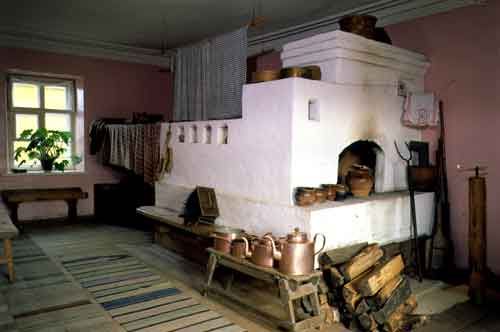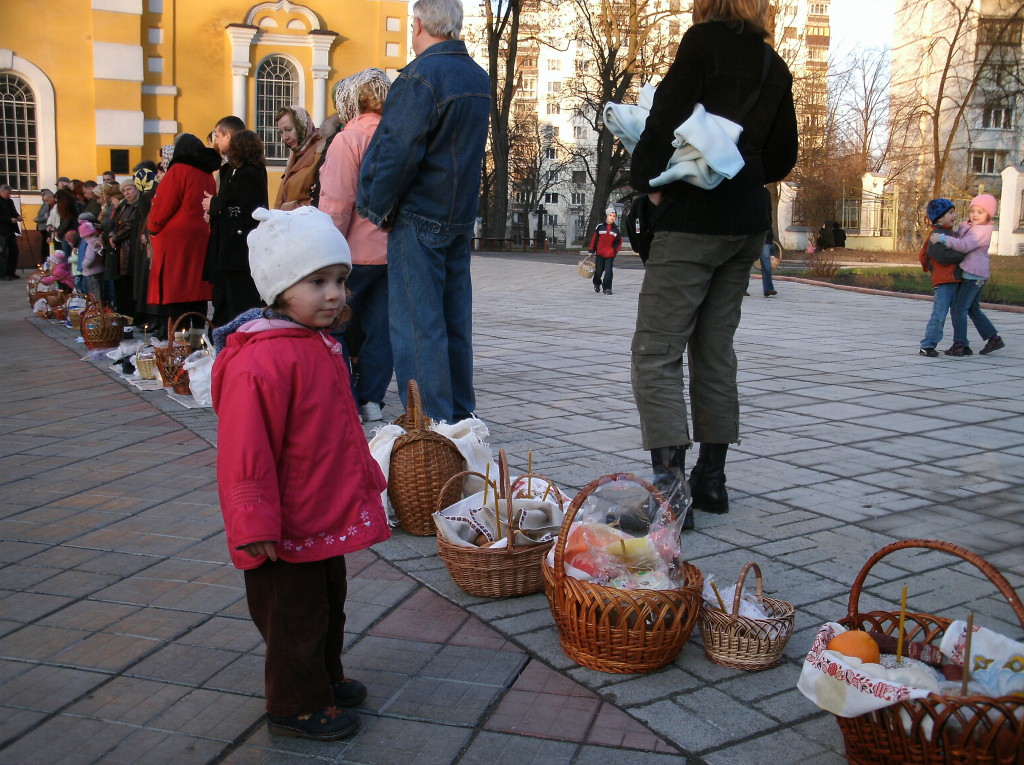One of the sweetest memories I have about my childhood in Ukraine is celebrating Easter.
We did not have any candies, egg hunt or huge baskets with oversized bunnies or filled with present.
But it still was very exciting holiday because Ukrainian Easter celebrations are a beautiful melding of traditional Christian practices, folklore, and ancient pagan symbolism. Some traditions will be familiar to Christians all around the world, while others are uniquely Ukrainian.

My son is enjoying Easter in Ukraine with his Dear Friend.
Lent and Holy Week
The biggest joy of Eater Sunday for many people simply comes from enjoying food-eggs, sweet bread and meat- that they did not eat for the past 6 weeks during lent. Lent – the period of fasting before Easter — is practiced in Ukraine much as it is elsewhere. Religious observant refrain from eating animal products: meat, eggs, and dairy. Now imagine how exited you would be to feast after weeks of very moderate diet?
The whole week before Ester Sunday is devoted to the preparations for the actual Easter celebration
Holy Week – as it is called– begins with Willow Sunday. In most countries this celebration of Christ’s entry into Jerusalem is called Palm Sunday, but a combination of pre-Christian pagan symbolism and a lack of local palm trees led Ukrainians to adopt willow switches as their symbolic branches.

Willow Sunday
Monday, Tuesday and Wednesday are spent preparing food for the Easter: dyeing eggs, baking eastern bread Paska and roasting meat. All of the food has to be prepared by so called Clean Thursday, because on that day we have a different chore – cleaning the house and yourself. My grandmother would wake me and my sister up and take us to a closest creek. We had to rinse our faces with freezing cold water as the sun was rising. That was really refreshing and we were wide awake after this early washing! Also she believed that this procedure will give us beauty as we grow up into young ladies.
Good Friday is also called Mourning Friday because it is the day when Christ had died. People are not supposed to eat anything and spend the day on the service in church. No work is allowed either.
Saturday is the rest day because there is a whole night service coming and you have to be wide awake.
Now let’s jump to the delicious part of the Easter and this article.
Pysanka (Dyed Eggs)
Ukraine’s most famous cultural product may be its colorfully dyed eggs.
Pysanka (which comes from the Ukrainian word for “to write”) are not painted; instead, designs are traced out in beeswax and the egg is then dipped into dye. The dye colors the egg where it is bare but leaves it white where the wax protects it. The process is then repeated as many times as desired (working from the lightest dye to the darkest) to create an intricate, many-layered pattern.
Most people these days call any patterned Ukrainian Easter egg a “pysanka,” but there are dozens of terms referring to specific methods of preparation. The most important difference to know is that “pysanka” are raw eggs (sometimes drained through a tiny drilled hole so that they may be preserved), while “krashanky” are dyed hardboiled eggs, usually one simple color, meant for eating at the Easter feast.

Ukrainian Easter Eggs “Pysanky”. Photo Credit to RTLibrary.
“Pysanka” is a piece of art and requires good amount of time to create it. That is why most people dye couple dozens of “krashanky”. Traditionally Ukrainians used natural dyes like onion peel for rich mahogany and beet root for reds and pinks. Nowadays you can find a wide range of food coloring to dye Ester Eggs.
The symbolism of eggs as religious objects dates back to Ukraine’s pre-Christian past, and decorated eggs have always been a part of religious celebrations there. Decorating eggs for Easter was banned under Soviet rule as a religious practice, but kept alive by many crafters working in secret.

“Krashanky”
There are many non-Biblical religious legends about eggs in Ukraine, including a basket of eggs that Mary Magdalene brought for her food when she went to the sepulcher to anoint Christ’s body. According to the legend, when she uncovered the eggs at the tomb, the white shells had been miraculously turned all the colors of the rainbow.
Bread (Paska)

Traditional Ukrainian “Paska” – Easter Bread.
My grandmother baked all her Eastern bread Paskas in old fashion “pich” – Ukrainian stove. I loved to wake up to heavenly aroma and beautiful sight of a dozen paskas in tin cans rising in a stove. Traditional paska loaves are tall and cylindrical, with symbols made of rolled dough or dusted in flour on the top.
The production of the paska was traditionally a ceremonial affair, during which the household was expected to stay quiet and still. We could really get in trouble with my sister if we would slam the door when entering the room where the dough was rising! The recipes of Paskas vary from area to area. In my mom’s city they always baked very sweet and fluffy Paskas and in my dad’s native land they were more savory and dense. The women preparing the bread were told to keep their thoughts pure as they kneaded it. Men sometimes stood guard outside the home to ward off evil spirits during the making of the paska (and to keep out neighbors, so that the household stayed quiet).

This kind of fireplace my grandmother used to bake her bread and cook other food.
Easter Baskets & Easter Mass
The paska bread, along with dyed krashanky eggs and non-Lenten foods like sausage, cheese, lard, and ham, is placed in a basket with lit candles and brought to church for Mass on Easter morning. (Midnight masses are traditional, but some modern churches do a daytime mass in the morning nowadays.)
Services often include a procession around the church. Many churches put up a mock sepulcher or black draping on Good Friday, and those are removed by the congregation as part of the procession.
The Easter baskets are blessed by the priest as part of the mass, and taken home by the families to eat in the morning.

My daughter is waiting for priest to come and bless baskets of food.
Easter Sunday
After the mass (and sometimes after going back to sleep), families celebrate Easter morning with a feast from their Easter baskets. The paska, meat, cheese, and other “feast” foods are consumed, breaking the Lenten fast.
Many households begin the feast with the dyed krashanky eggs. All kids favorite part of the morning is the game called “egg battles” or “egg knocking”: two people rap their eggs together, and if someone’s eggshell breaks, that person is out of the game (or has to give the egg up, or eat it, depending on family tradition).
Ukraine does not have the concept of an “Easter bunny,” or of Easter egg hunts, and chocolate and candy do not play a traditional role. These days the Easter basket might include a bit of chocolate, but the savory treats are still the focus of the morning meal.

“Egg Battle” Is Really Fun For Kids.
Remembering Those Who Passed Away
Easter celebrations traditionally extend into the next week in Ukraine.
The week after Easter is also a time for memorializing the dead in Ukraine. Families bring baskets of food and small gifts to cemeteries and leave them for their ancestors. This is often a religious ceremony, accompanied by a priest who blesses the graves. Every region and village has it its own day for this ceremony but usually it stays within the range of 1 week after the Easter Sunday. Thankfully for this tradition I became knowledgeable about my great-great relatives, stories of their lives and where I come from.

Remembering ancestors. This day is cold “Grobky”.
From start to finish, Ukrainian Easter is a long holiday season: all the way from Palm Sunday a week before Easter to the graveyard visits a week after! Of course in modern life for many families Easter traditions are no more than Saturday trip to the closest market to buy Paska, meat and Krashanky. Years of Soviet Union time did not help to pass real traditions to young people, but thanks to our dear Ukrainian “babushkas” all the extended customs are kept alive. Many of the traditions are unique to Ukraine, and will hopefully go on flourishing for many more generations.
